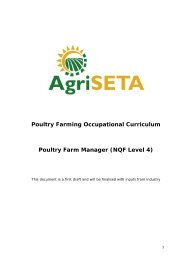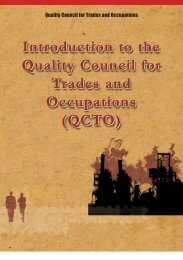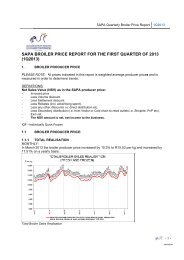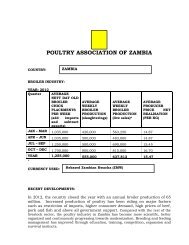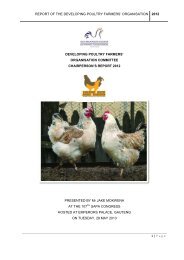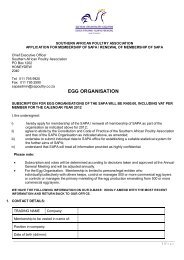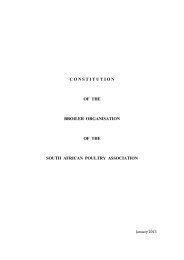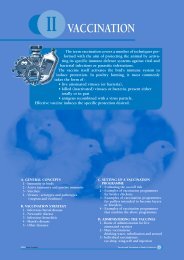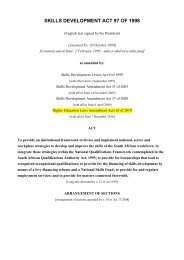Poultry Farming Occupational Curriculum Poultry Farm ... - SAPA
Poultry Farming Occupational Curriculum Poultry Farm ... - SAPA
Poultry Farming Occupational Curriculum Poultry Farm ... - SAPA
You also want an ePaper? Increase the reach of your titles
YUMPU automatically turns print PDFs into web optimized ePapers that Google loves.
<strong>Poultry</strong> <strong><strong>Farm</strong>ing</strong> <strong>Occupational</strong> <strong>Curriculum</strong><br />
<strong>Poultry</strong> <strong>Farm</strong> Supervisor (NQF Level 3)<br />
This document will be refined during the pubic verification process and a pilot<br />
learnership project.<br />
Qualification Development Facilitator: Herman van Deventer<br />
Learner-QDF: Onicca Moloto<br />
1
TABLE OF CONTENTS<br />
Section 1: <strong>Curriculum</strong> Overview ..................................................................... 3<br />
1. <strong>Occupational</strong> Information .......................................................................... 3<br />
1.1 <strong>Occupational</strong> Cluster ........................................................................... 3<br />
1.2 <strong>Occupational</strong> Field ............................................................................... 3<br />
1.3 Related Occupation ............................................................................. 3<br />
2. Qualification Focus and Progression ............................................................ 3<br />
3. <strong>Occupational</strong> Profile .................................................................................. 4<br />
3.1 Purpose Statement.............................................................................. 4<br />
3.2 <strong>Occupational</strong> Tasks ............................................................................. 4<br />
4. <strong>Curriculum</strong> Structure ................................................................................ 4<br />
5. Current Learning Programmes and/or Qualifications that will replaced by the<br />
<strong>Occupational</strong> Qualification ................................................................................ 5<br />
6. <strong>Curriculum</strong> Requirements .......................................................................... 5<br />
6.1 Educational Entry Requirements ........................................................... 5<br />
6.2 Physical Entry Requirements ................................................................ 5<br />
6.3 Legal Entry Requirements .................................................................... 5<br />
Section 2: <strong>Curriculum</strong> Components ................................................................ 6<br />
7. Subject Specifications ............................................................................... 6<br />
7.1 Operations Supervision ........................................................................ 6<br />
7.2 <strong>Poultry</strong> Production ............................................................................. 12<br />
8. Practical Skills Modules ........................................................................... 19<br />
8.1 Direct and control the performance and conduct of individual employees and<br />
teams 19<br />
8.2 Recognise and attend to poultry production-related problems observed ... 24<br />
9. Work Experience Modules ........................................................................ 29<br />
9.1 Motivated and productive work teams ................................................. 29<br />
9.2 Production problems and queries are addressed .................................... 31<br />
2
<strong>Curriculum</strong> Document<br />
Nr:<br />
612201<br />
Qualification Title:<br />
National Award: <strong>Poultry</strong> <strong>Farm</strong> Supervisor<br />
Document Status Date Version<br />
Draft 17/08/2011 2<br />
Development<br />
Quality<br />
Partner<br />
Name E-mail Phone<br />
AgriSETA info@agriseta.co.za (012) 325 1655<br />
Section 1: <strong>Curriculum</strong> Overview<br />
1. <strong>Occupational</strong> Information<br />
1.1 <strong>Occupational</strong> Cluster<br />
To be specified<br />
1.2 <strong>Occupational</strong> Field<br />
To be specified<br />
1.3 Related Occupation<br />
612201: <strong>Poultry</strong> <strong>Farm</strong> Manager<br />
2. Qualification Focus and Progression<br />
The <strong>Occupational</strong> qualification for <strong>Poultry</strong> <strong>Farm</strong> Supervisors is an introductory<br />
qualification in <strong>Poultry</strong> <strong>Farm</strong> Management for persons in a commercial farming unit as<br />
well as for persons practicing small scale poultry farming. The qualification is designed<br />
to address areas of supervision as well as the poultry production problem-solving role<br />
related to generic poultry farming practices. Specific areas of contextual competence<br />
for specific poultry production systems, such as layers, broilers and breeders will be<br />
addressed during the work experience or production experience components of the<br />
qualification. Specific contextual components still requires further refinement and will<br />
be addressed during the piloting phase of the curriculum design process. This<br />
approach promotes portability of the qualification within the various poultry production<br />
systems.<br />
Progression to higher levels of learning and associated career opportunities is<br />
addressed by means of further occupational qualifications in first line management of<br />
poultry farming production units.<br />
A specific need for further learning in agricultural entrepreneurship is recognised for<br />
small scale poultry farmers and will be developed as a generic occupational<br />
qualification.<br />
3
3. <strong>Occupational</strong> Profile<br />
3.1 Purpose Statement<br />
<strong>Poultry</strong> <strong>Farm</strong> Supervisors: Supervises the activities executed in a poultry production<br />
unit by monitoring and controlling work teams, organising the availability of materials<br />
and resources and providing direction to address production related problems.<br />
3.2 <strong>Occupational</strong> Tasks<br />
<strong>Occupational</strong> Task 1: Monitoring and controlling the execution of tasks by<br />
work teams to achieve motivated and productive work teams (NQF Level:3)<br />
Unique Product or Service<br />
Motivated and productive work teams<br />
<strong>Occupational</strong> Responsibility<br />
Direct and control the performance and conduct of individual employees and teams<br />
<strong>Occupational</strong> Context<br />
Supervise the activities of work teams and individuals employed in a poultry<br />
production unit, adhere to workplace policies and procedures and report to person in<br />
authority<br />
<strong>Occupational</strong> Task 2: Correcting poultry production-related problems<br />
observed and providing guidance on production questions raised by<br />
subordinates (NQF Level 3)<br />
Unique Product or Service<br />
Production problems and queries are addressed<br />
<strong>Occupational</strong> Responsibility<br />
Recognise and attend to poultry production-related problems observed<br />
<strong>Occupational</strong> Context<br />
A poultry rearing or production house and surrounding grounds, report to persons in<br />
authority and addressing production problems in accordance with and adhering to<br />
standard workplace practices and procedures.<br />
4. <strong>Curriculum</strong> Structure<br />
Subjects<br />
Number Title NQF Level Credits<br />
Operations Supervision 3 8<br />
<strong>Poultry</strong> production 3 8<br />
Total Knowledge Credits 16<br />
4
Practical Skills Modules<br />
Number Title NQF Level Credits<br />
Direct and control the performance and conduct<br />
of individual employees and teams<br />
Recognise and attend to poultry production<br />
related problems observed<br />
3 6<br />
3 6<br />
Total Practical Credits 12<br />
Work Experience Modules<br />
Number Title NQF Level Credits<br />
Motivated and productive work teams 3 12<br />
Production problems and queries are addressed 3 12<br />
Total Workplace Credits 24<br />
Total Qualification Credits 52<br />
Knowledge<br />
Credits:<br />
31%<br />
Practical<br />
Credits:<br />
23%<br />
Workplace<br />
Credits:<br />
46%<br />
5. Current Learning Programmes and/or Qualifications that<br />
will replaced by the <strong>Occupational</strong> Qualification<br />
Nr Title Type<br />
NQF<br />
Level<br />
6. <strong>Curriculum</strong> Requirements<br />
6.1 Educational Entry Requirements<br />
Grade 12 or Foundational Certificates in Communication and Mathematical Literacy<br />
6.2 Physical Entry Requirements<br />
None specified<br />
6.3 Legal Entry Requirements<br />
None specified in addition to statutory regulations<br />
5
Section 2: <strong>Curriculum</strong> Components<br />
7. Subject Specifications<br />
7.1 Operations Supervision<br />
Title<br />
Operations Supervision<br />
Subject Number -KS-1 NQF Level 3 Credits 8<br />
Purpose<br />
The purpose of the learning in this subject relates to:<br />
The disciplinary or conceptual knowledge (including theory) related to the supervision<br />
of individuals and work teams. The learners are expected to gain disciplinary<br />
knowledge in Operational Supervision before progressing to the higher level<br />
disciplinary studies in Operational Management included in this curriculum.<br />
This includes learning related to:<br />
• Introduction to supervision<br />
• Performance management<br />
• Motivation and team leadership concepts<br />
• First line discipline<br />
• Basic production cost concepts<br />
• Work efficiency and effectiveness<br />
Topic Content Guidelines<br />
Topic 1: Introduction to supervision<br />
Topic Elements<br />
Role of supervisors<br />
Range:<br />
• Define supervision<br />
• Roles and responsibilities of supervisors<br />
• The use of standard workplace practices and procedures to direct work process<br />
Planning, organising, directing and controlling<br />
Range:<br />
• The functions of the supervisor in terms of planning, organising, directing and<br />
controlling teams<br />
Assessment Criteria<br />
• Explain the roles and responsibilities of a supervisor<br />
• Debate/motivate the importance of standard workplace practices and procedures as<br />
6
measures to improve production levels according to expected quality standards.<br />
• Debate/motivate the importance of standard workplace practices and procedures as<br />
measures to limit potential production-related problems, health and safety risks or<br />
deviation from expected quality standards<br />
Topic 2: Performance management<br />
Topic Elements<br />
Setting goals<br />
Range:<br />
• Importance of goals<br />
• Principles of setting SMART goals<br />
Formulating instructions<br />
Range:<br />
• The importance of clear instruction<br />
• How to formulate a good instructions<br />
• Methods used for testing and ensuring understanding by the recipient<br />
Controlling standards of performance<br />
Range:<br />
• Define performance standards<br />
• Methods to keep track of performance<br />
• Common reasons for poor performance and correcting these<br />
• The use of coaching to address performance problems<br />
Assessment Criteria<br />
• Draft goal statements that meet SMART criteria<br />
• Formulate and issue a verbal instruction<br />
• Formulate and record a written instruction<br />
• Draft a performance standard<br />
• Select and motivate specific steps to correct a range of performance-related<br />
problems<br />
Topic 3: Motivation and team leadership concepts<br />
Topic Elements<br />
Understanding motivation<br />
Range:<br />
• Define motivation<br />
• Basic concepts of motivation<br />
Understanding teams<br />
7
Range:<br />
• Defining teams<br />
• Team dynamics<br />
• Team building<br />
• Effective team communication<br />
Interpersonal and people relations<br />
Range:<br />
• Developing effective work relations<br />
• Gaining respect<br />
• Diversity in the workplace<br />
• Workplace discrimination<br />
Assessment Criteria<br />
• Explain motivational concepts by using practical examples<br />
• List methods of how to improve interpersonal relationships in a team<br />
• List a number of causes of problems related to interpersonal work relations and<br />
formulate practical recommendation to address these<br />
• Explain strategies to accommodate diversity in the workplace based on small case<br />
studies<br />
Topic 4: First-line discipline<br />
Topic Elements<br />
The supervisor’s role in maintaining workplace discipline<br />
Range:<br />
• Importance of work discipline<br />
• Concept of fairness<br />
• Maintaining discipline<br />
Disciplinary codes and procedures<br />
Range:<br />
• Codes of conduct<br />
• Informal and formal disciplinary procedures<br />
• Issuing warnings and recording disciplinary action<br />
Introduction to workplace conflict and grievances<br />
Range:<br />
• Sources of conflict and resolving conflict<br />
• Dealing with inappropriate, conflict causing behaviour<br />
• Grievance resolution procedures<br />
8
Assessment Criteria<br />
• Explain the supervisor’s role in maintaining workplace discipline<br />
• Distinguish between different categories of misconduct<br />
• Define the concepts of fairness in terms of practical workplace examples<br />
• Describe informal and formal disciplinary procedures<br />
• Explain how workplace conflict should be dealt with to prevent an escalation in<br />
conflict based on a case study<br />
• Describe a grievance procedure to resolve an individual grievance<br />
Topic 5: Basic production costs concepts<br />
Topic Elements<br />
Income vs profit<br />
Range:<br />
• Defining income and profits<br />
• The profit motive of a business<br />
Production cost control<br />
Range:<br />
• Elements of production costs<br />
• How to limit input costs<br />
• The relationship between earnings, profits and cost control<br />
• Cost consequences of inefficiency and re-work<br />
• Cost consequences of absenteeism<br />
• Cost consequences of waste<br />
• Cost consequences of injuries on duty<br />
Assessment Criteria<br />
• Explain the concept “cost of production” and factors that impact on this<br />
• Calculate the income and profit of a production unit<br />
• Explain how input costs can be limited in the various areas of production<br />
• Explain how losses can be limited in the various areas of production<br />
Topic 6: Work efficiency and effectiveness<br />
Topic Elements<br />
Productivity<br />
Range:<br />
• Defining productivity<br />
• Productivity measurement<br />
• Productivity improvement<br />
9
Weekly/Daily activity planning<br />
Range:<br />
• Organising and prioritising time<br />
• Using planning aids to manage time (e.g. diary, white board, etc.)<br />
• Drawing up weekly and daily time schedules<br />
• Following up on planned activities<br />
Assessment Criteria<br />
• Describe 5 methods to improve productivity in a sustainable fresh produce packing<br />
environment<br />
• Plan a weekly activity schedule based on a case study<br />
• Calculate the productivity improvement/decrease in a given scenario<br />
Internal assessment guidelines for providers<br />
Critical Knowledge Areas:<br />
• Role of supervisors<br />
• Setting goals<br />
• Formulating instructions<br />
• Controlling performance<br />
• Leading a team<br />
• Interpersonal and people relations<br />
• The supervisors role in maintaining discipline<br />
• Production cost control<br />
• Daily activity planning<br />
Assessment Distribution<br />
Topic<br />
Weighting<br />
Principles of supervision 10<br />
Performance management 20<br />
Motivation and team leadership concepts 20<br />
First-line discipline 10<br />
Basic production cost concepts 15<br />
Work efficiency and effectiveness 25<br />
10
Assessment Standards<br />
• Listed critical knowledge areas selected must always be included in the external<br />
summative assessment.<br />
• Learners must achieve a normative assessment rating of 70% on all questions<br />
related to the critical knowledge areas to be deemed competent<br />
• Learners must achieve a normative assessment rating of 50% on all questions<br />
asked in addition to the critical knowledge areas to be deemed competent<br />
Skills development provider accreditation criteria<br />
Physical Requirements<br />
• Learning resources approved by the QAP<br />
• Assessment documentation, instruments and standards approved by AQP<br />
Human Resource Requirements<br />
• Facilitators of learning approved by the AQP<br />
• Assessors approved by the AQP<br />
• The capacity to conduct internal quality assurance by employed staff or contracted<br />
experts<br />
• Assessments will be conducted by a person who meets the following requirements:<br />
• Has at least 5 years experience in a supervisor position, or<br />
• Has obtained a nationally recognised qualification in supervision not lower<br />
than NQF level 4 with at least 3 years relevant experience, or<br />
• Gained at least 1 year experience in assessment practice<br />
Legal Requirements<br />
• As dictated by the <strong>Occupational</strong> Health, Safety and Environmental Control statutes<br />
Exemptions<br />
Qualification or Learning programmes that can give you exemption for this<br />
Knowledge Subject Specification:<br />
Number Title Institution NQF Level<br />
To be verified<br />
11
7.2 <strong>Poultry</strong> Production<br />
Title<br />
<strong>Poultry</strong> Production<br />
Subject Number -KS-2 NQF Level 3 Credits 8<br />
Purpose<br />
The purpose of the learning in this subject relates to:<br />
The disciplinary or conceptual knowledge (including theory) related to addressing<br />
production problems and queries raised by subordinates on poultry production.<br />
This includes learning related to:<br />
• The poultry industry in South Africa<br />
• Functional anatomy and physiology of birds<br />
• <strong>Poultry</strong> nutrition management<br />
• Water management<br />
• Environmental management<br />
• <strong>Poultry</strong> health management<br />
Topic Content Guidelines<br />
Topic 1: The poultry industry in South Africa<br />
Topic elements<br />
The supply chain of the poultry industry<br />
Range:<br />
• Origin and development of genetic lines for meat and egg production. (Great Grand<br />
Parents to Grand Parents, to Parents stock and commercial birds.<br />
• Role of hatcheries to maintain bio-security in the supply chain.<br />
• The production and marketing of poultry meat and eggs<br />
• <strong>Poultry</strong> industry’s contribution to GDP<br />
Assessment criteria<br />
• Briefly explain why birds for either meat or egg production have been developed<br />
• Briefly explain the role of hatcheries in the supply chains of egg and meat<br />
production.<br />
• Explain the integration of the production and marketing of poultry products.<br />
• Compare the GDP of poultry products relative to other agricultural commodities.<br />
Topic 2: Functional anatomy and physiology of birds<br />
Topic Elements<br />
Digestive and excretory systems<br />
Range:<br />
• The gastro-intestinal tract and associated organs (liver, gall, pancreas, salivary<br />
12
glands)<br />
• Digestion and absorption of nutrients<br />
• Transport of nutrients in the body<br />
• Excretory organs and waste products (cloaca, kidneys, urine)<br />
Cardiovascular system (Blood circulatory system)<br />
Range:<br />
• The parts of the cardiovascular system (heart, veins, arteries)<br />
• Constituents of blood (water, red and white blood cells, antibodies, proteins,<br />
minerals, glucose, fats, amino acids)<br />
• Nutrients and waste products transport (minerals, glucose, fats, amino acids, uric<br />
acid)<br />
• The role in body temperature regulation (heat transfer)<br />
• Disease control (circulating antibodies)<br />
Respiratory system<br />
Range:<br />
• The functions of the different parts of the respiratory system (mucous lining and<br />
protective function, bronchi, lungs and air sacs)<br />
• Oxygen supply and carbon dioxide removal<br />
• Combustion processes occurring in body tissue<br />
• Body temperature regulation by means of panting<br />
Musculo-skeletal system<br />
Range:<br />
• Skeleton as framework for muscle attachment (movement)<br />
• Skeleton as protection for internal organs<br />
• Medullary bone as source of calcium<br />
• The contractile functions of muscle tissue (feed passage, respiration, blood<br />
circulation, heat production)<br />
Immune system<br />
Range:<br />
• Immune development (vaccines, antigens, antibodies)<br />
• The organs involved in antibody formation (thymus glands, bone marrow,<br />
Harderian gland, spleen, Bursa of Fabricius, cecal tonsils, gastro-intestinal tract)<br />
Reproductive system<br />
Range:<br />
• Female reproductive system (ovary, yolk and eggshell formation, ovulation)<br />
• Male reproductive system (testes, sperm tubes, cloaca)<br />
13
• Mating and sperm transfer<br />
Assessment criteria<br />
• Identify and describe the functions of the different parts of the gastro-intestinal<br />
tract and associated organs<br />
• Explain the nutrient uptake and transportation of nutrients<br />
• Briefly explain the nature and origin of the excretory products<br />
• List and describe the functions of the different parts and constituents of the<br />
cardiovascular system<br />
• Briefly explain the role of the cardiovascular system in the transport of nutrients<br />
and waste products<br />
• Briefly explain the role of the cardiovascular system in body temperature regulation<br />
• Briefly explain the role of the cardiovascular system in health management<br />
• Describe the role of the respiratory system to protect the bird against bacterial<br />
penetration<br />
• Identify and describe the function of the different parts of the respiratory system<br />
(lungs and air sacs)<br />
• Explain the origin of carbon dioxide and heat production in body tissue<br />
• Explain the role of the respiratory system in body temperature regulation during<br />
extreme climatic conditions<br />
• Explain the importance and function of a well-developed frame (skeleton)<br />
• Briefly describe the processes responsible for movement and respiration in the bird<br />
• Explain the function of the skeleton as source of nutrients for eggshell formation<br />
• Explain the function of muscle tissue in processes such as feed digestion, blood<br />
circulation, respiration and heat production.<br />
• Explain the principles of immunisation and reasons for vaccinating and<br />
revaccinating (antigen types, disease challenge, titer counts)<br />
• Identify and explain the function of the organs responsible for immune<br />
development<br />
• Describe the processes involved for the evaluation of the immune status of poultry<br />
• Identify and discuss the different parts of the female and male reproductive<br />
systems<br />
• Explain the process of ovulation and fertilisation<br />
Topic 3: <strong>Poultry</strong> nutrition management<br />
Topic Elements<br />
<strong>Poultry</strong> Nutrition<br />
Range:<br />
• Basic concepts of nutrients and their functions (growth, egg production, energy,<br />
amino acids, minerals and vitamins)<br />
• The most commonly used raw materials for the supply of nutrients in poultry diets<br />
(grains, protein sources, minerals and vitamins)<br />
• Factors that affect feed intake by poultry (disease, environmental temperature and<br />
production level)<br />
14
Assessment Criteria<br />
• Explain the basic functions of energy, proteins, vitamins and minerals<br />
• Briefly explain the main sources of energy, proteins, vitamins and minerals for<br />
poultry diets<br />
• Explain briefly factors affecting nutrient requirements (environmental temperature,<br />
growth rate, production level and health status)<br />
Topic 4: Water management<br />
Topic Elements<br />
Functions of water in the body<br />
Range:<br />
• Water balance (plasma and cell content, dehydration)<br />
• Digestion of feed and transport of nutrients<br />
• Body temperature maintenance<br />
• Excretion of waste products (uric acid, indigestible material)<br />
Water quality<br />
Range:<br />
• Water safety (mineral and bacterial contaminants)<br />
Water in health management<br />
Range:<br />
• Maintenance of mucous membranes<br />
Assessment criteria<br />
• Explain the importance of water balance in poultry<br />
• Explain the role of water in digestion, transport of nutrients, body temperature<br />
regulation and the excretion of waste products<br />
• Explain the reasons for water quality tests<br />
• Explain the role of water to control bacterial infections of the respiratory tract<br />
under in dusty conditions<br />
Topic 5: Environmental Management<br />
Topic Elements<br />
Ventilation and air movement<br />
Range:<br />
• Mechanical ventilation (air velocity, air leaks, dust, louver openings, heat and<br />
moisture removal)<br />
• Natural ventilation (wind speed, curtain openings)<br />
• Health management (dust, ammonia control)<br />
15
• Thermo-neutral environment<br />
• Heat production and heat loss by the bird (convection, radiation, conduction,<br />
evaporative heat loss)<br />
Light intensity and photoperiods<br />
Range:<br />
• Effect of light on growth and egg production<br />
Assessment Criteria<br />
• Explain the factors affecting the efficiency of mechanical ventilation in poultry<br />
buildings<br />
• Explain the factors affecting the efficiency of natural ventilation in poultry buildings<br />
• Discuss the importance of ventilation in health management of poultry<br />
• Discuss the effect of temperature extremes on production efficiency<br />
• Discuss the mechanisms of heat production and heat loss by the bird.<br />
• Briefly explain the nature of light<br />
• Briefly explain the effect of photoperiod and light intensity on growth of poultry<br />
• Briefly explain the effect of photoperiod and light intensity on sexual maturity and<br />
egg production<br />
Topic 6: <strong>Poultry</strong> health management<br />
Topic Elements<br />
<strong>Poultry</strong> health management<br />
Range:<br />
• The nature of disease-causing organisms (viruses, bacteria, protozoa, fungi,<br />
parasites)<br />
• Aggravating factors that cause disease (high levels of disease-causing organisms,<br />
poor sanitation, poor immune and nutritional status, high stocking density, poor<br />
ventilation, ammonia and fungus growth)<br />
• Mitigating factors to prevent the onset of disease (vector control, low exposure,<br />
correct vaccination practices)<br />
• Typical symptoms of common poultry diseases (respiratory problems, lameness,<br />
misshapen and discolouration of eggshells, bloody excretions in faeces,<br />
colisepticaemia, airsacculitis)<br />
Assessment Criteria<br />
• Describe the nature of disease-causing organisms in poultry production<br />
• Describe aggravating factors that can result in the onset of disease<br />
• Describe mitigating that can assist to control the onset of disease<br />
• Describe typical symptoms for the most common poultry diseases<br />
Internal assessment guidelines for providers<br />
16
Critical Knowledge Areas:<br />
• The poultry industry in South Africa<br />
• Functional anatomy and physiology of birds<br />
• <strong>Poultry</strong> nutrition management<br />
• Water management<br />
• Environmental management<br />
• <strong>Poultry</strong> health management<br />
Assessment Distribution<br />
Topic<br />
Weighting<br />
The poultry supply chain 5<br />
Functional Anatomy and physiology of birds 20<br />
Environmental management 20<br />
<strong>Poultry</strong> health management 25<br />
<strong>Poultry</strong> nutrition management 15<br />
Water management 15<br />
Assessment Standard<br />
• Listed critical knowledge areas selected must always be included in the external<br />
summative assessment.<br />
• Learners must achieve a normative assessment rating of 70% on all questions<br />
related to the critical knowledge areas to be deemed competent<br />
• Learners must achieve a normative assessment rating of 50% on all questions<br />
asked in addition to the critical knowledge areas to be deemed competent<br />
Skills development provider accreditation criteria<br />
Physical Requirements<br />
• Learning resources approved by the <strong>SAPA</strong><br />
• Assessment documentation, instruments and standards approved by <strong>SAPA</strong><br />
Human Resource Requirements<br />
• Facilitators of learning approved by <strong>SAPA</strong><br />
• Assessors approved by <strong>SAPA</strong><br />
• The capacity to conduct internal quality assurance by employed staff or contracted<br />
experts<br />
• Assessments will be conducted by a person who meets the following requirements:<br />
• Has at least 5 years experience in a poultry farm supervisor position, or<br />
• Has obtained a nationally recognised qualification in <strong>Poultry</strong> <strong>Farm</strong> Supervision<br />
not lower than NQF level 4 with at least 3 years experience, or<br />
17
• Gained at least 1 year experience in assessment practice<br />
Legal Requirements<br />
• As dictated by the <strong>SAPA</strong> rules and regulations<br />
Exemptions<br />
Qualification or Learning programs that can give you exemption for this<br />
Knowledge Subject Specification:<br />
Number Title Institution NQF Level<br />
To be verified<br />
18
8. Practical Skills Modules<br />
8.1 Direct and control the performance and conduct of individual<br />
employees and teams<br />
Title<br />
Direct and control the performance and conduct of<br />
individual employees and teams<br />
Subject Number –PM-1 NQF Level 3 Credits 6<br />
Purpose of the module<br />
The focus of the learning in this module is to provide learners with the<br />
opportunity to:<br />
• Direct the performance and conduct of employees, and<br />
• Resolve problems related to conduct or performance<br />
This must include learning activities to:<br />
• Apply shop floor discipline and attend to grievances<br />
• Deal with shop floor conflict<br />
• Determine staffing needs and allocate subordinates accordingly<br />
• Formulate and issue clear and assertive instructions<br />
• Set work targets, monitor and report on achievement<br />
• Demonstrate a work activity<br />
Learning Activity Guidelines<br />
Practical Skill: Apply shop floor discipline and attend to grievances<br />
Learning Activity Guidelines:<br />
Given case studies with a variety of common shop floor situations involving discipline<br />
and grievances, standard policies and procedures, learners must be able to:<br />
• Assess the given case studies and distinguish between misconduct, poor<br />
performance and grievance situations<br />
• Classify misconduct against standard codes of conduct<br />
• Determine severity of transgressions/grievance and formulate appropriate action<br />
Applied Knowledge:<br />
• Disciplinary codes and procedures<br />
• Grievance procedures<br />
Assessment Criteria:<br />
1. Question applied knowledge on:<br />
• Good practices related to first line discipline<br />
• Good practices related to grievance procedures<br />
19
2. Observe behaviour or process<br />
• None<br />
3. Evaluate products<br />
• Formulated written responses given by the learner to the different scenarios on the<br />
presented case study<br />
Practical Skill: Deal with shop floor conflict<br />
Learning Activity Guidelines:<br />
Given a scenario of shop floor conflict situations and participating members, learners<br />
must be able to:<br />
• Identify possible sources of conflict<br />
• Decide on appropriate method to deal with conflict<br />
• Facilitate resolution of conflict between parties in a simulated role-play<br />
• Record resolution in applicable manner<br />
Applied Knowledge:<br />
• Sources of conflict<br />
• Conflict resolution practices<br />
• Inter-personnel communication practices<br />
• Dealing with inappropriate, conflict causing behaviour<br />
Assessment Criteria:<br />
1. Question applied knowledge on:<br />
• Conflict resolution practices that will achieve desired outcome in the presented<br />
situation<br />
2. Observe behaviour or process<br />
• Interaction with participating members – the aggrieved parties – is structured, fair<br />
and solution orientated<br />
3. Evaluate products<br />
• Completed documentation and records of proceedings are evaluated for<br />
completeness and accuracy<br />
Practical Skill: Determine staffing needs and allocate subordinates<br />
accordingly<br />
Learning Activity Guidelines:<br />
Given case studies of work outputs that must be achieved and numbers and profiles of<br />
staff available, learners must be able to:<br />
• Estimate number of staff needed for the achievement of given targets<br />
• Allocate work to specific persons, who are best qualified<br />
• Draw up a schedule to develop the capacity of staff that will enhance their skills by<br />
exposing them to different roles<br />
Applied Knowledge:<br />
20
• Calculating staff requirements against defined work outputs<br />
• Practices to allocate staff in terms of their experience or competencies<br />
• Practices on staff rotation and development of multi skills<br />
Assessment Criteria:<br />
1. Question applied knowledge on:<br />
• Method of calculating staffing needs based on norms<br />
• Reasoning behind allocations made to specific work stations<br />
2. Observe behaviour or process<br />
• None<br />
3. Evaluate products<br />
• Accuracy of calculations (headcounts) as per produce norm<br />
• Accuracy of staff allocations according to given criteria<br />
Practical Skill: Formulate and issue clear and assertive instructions<br />
Learning Activity Guidelines:<br />
Given scenarios of work that have to be completed in specific time frames, learners<br />
must be able to:<br />
• Issue a verbal instruction to a subordinate that clearly defines expected scope and<br />
standard of work to be completed<br />
• Draft a written instruction to a subordinate that clearly defines expected scope and<br />
standard of work to be completed<br />
Applied Knowledge:<br />
• Written instruction practices<br />
• Verbal instructions practices<br />
• Assertiveness<br />
Assessment Criteria:<br />
1. Question applied knowledge on:<br />
• Elements of good verbal instructions<br />
2. Observe behaviour or process<br />
• Good instruction practices are used when giving oral instructions to subordinates<br />
3. Evaluate products<br />
• Written instructions are clear and well structured<br />
Practical Skill: Set work targets, monitor and report on achievement<br />
Learning Activity Guidelines:<br />
Given examples of production schedules and work targets, number of staff, case<br />
studies of work outputs achieved (including failure to achieve targets), learners must<br />
be able to:<br />
21
• Set daily (as pertaining to a schedule) targets that are clear, realistic and<br />
measurable<br />
• Communicate targets in understandable terms or format<br />
• Develop a basic monitoring schedule defining what, when and how monitoring will<br />
be done<br />
• Provide visual display of the achievement of planned targets against given<br />
production data<br />
• Give oral feedback on achievement of targets in a simulated exercise<br />
Applied Knowledge:<br />
• Practices to set targets<br />
• Inter-personnel communication practices<br />
• Visual display of the achievement of targets<br />
Assessment Criteria:<br />
1. Question applied knowledge on:<br />
• The importance of SMART target setting practices<br />
• Critical elements of a visual display to communicate production targets and<br />
achievement against it<br />
2. Observe behaviour or process<br />
• Interaction when explaining targets and their achievement is clear, motivating and<br />
instructive<br />
3. Evaluate products<br />
• Documentation is evaluated for completeness and accuracy<br />
• Visual display of information is clear and achieves the desired communication<br />
purpose<br />
Practical Skill: Demonstrate a work activity<br />
Learning Activity Guidelines:<br />
Given a role play of a new employee and a specific task, learners must be able to:<br />
• Explain how the task must be done and the standard that must be achieved<br />
• Demonstrate the task<br />
• Allow an opportunity for questions<br />
• Observe whilst the “new employee” performs the task<br />
• Provide feedback to the “new employee”<br />
Applied Knowledge:<br />
• Demonstration practices<br />
Assessment Criteria:<br />
1. Question applied knowledge on:<br />
• The critical elements of an effective practical demonstration<br />
2. Observe behaviour or process<br />
22
• Interaction with the “new employee” receiving the demonstration is structured and<br />
clear<br />
• The feedback to the “new employee” is provided in a constructive manner that<br />
builds capacity and confidence<br />
3. Evaluate products<br />
• None<br />
Skills development provider accreditation criteria<br />
Physical Requirements<br />
• Structured examples and scenarios<br />
• Learner instructions and work sheets<br />
• Assessment instruments and standards for each practical skill that clearly defines<br />
standards of competence as competent or not yet competent<br />
• Reflective learning exercises<br />
Human Resource Requirements<br />
• Learner facilitator ratio of 1:15<br />
• Internal assessors can be the same person as the facilitator<br />
Legal Requirements<br />
• None specified in addition to standards prescribed by applicable legislation.<br />
Critical practical activities to be assessed externally<br />
• None specified<br />
Exemptions<br />
Qualification or Learning programmes that can give you exemption for this<br />
Practical Skills Module:<br />
Number Title Institution<br />
NQF<br />
Level<br />
None recognised<br />
23
8.2 Recognise and attend to poultry production-related problems<br />
observed<br />
Title<br />
Recognise and attend to poultry production related<br />
problems observed.<br />
Subject Number –PM-2 NQF Level 3 Credits 6<br />
Purpose of the module<br />
The focus of the learning in this module is to provide learners with the<br />
opportunity to:<br />
• Attend to problem areas with guidance and clear direction on implementation of<br />
corrective measures.<br />
This must include:<br />
• Recognising ventilation problems in mechanically ventilated buildings and<br />
formulating corrective action. (If applicable)<br />
• Recognising ventilation problems in naturally ventilated buildings and formulating<br />
corrective action. (If applicable)<br />
• Recognising sanitary factors that will impact on poultry health and formulating<br />
corrective action<br />
• Recognising problems caused by water/and or feed provision, and taking corrective<br />
action<br />
• Recognising factors that could negatively impact on immune development when<br />
vaccinating poultry<br />
Learning Activity Guidelines<br />
Practical Skill 1: Recognise ventilation problems in mechanically ventilated<br />
buildings and formulate corrective action<br />
Learning Activity Guidelines:<br />
Given scenarios of a range of ventilation problems that commonly occur in a poultry<br />
production unit, learners will be able to<br />
• Recognise signs that indicate air distribution problems<br />
• Establish potential causes of the problem<br />
• Isolate the most probable cause of the problem<br />
• Formulate the most appropriate corrective measures<br />
Applied Knowledge:<br />
• Observation of chicken behaviour<br />
• Ventilation problems, e.g. short-circuiting due to air leaks, incorrect setting of<br />
louver openings, low air speeds, wet areas of bedding material in building.<br />
Assessment Criteria:<br />
1. Question applied knowledge on:<br />
• Louvre settings<br />
24
• Air leaks<br />
• Fan speed settings and mechanical aspects of the fans<br />
• Set point temperature too low<br />
2. Observe behaviour or process<br />
• Inspection of the condition of the mechanical ventilation equipment<br />
• Problem isolated and possible corrective actions formulated<br />
3. Evaluate products<br />
• N.a.<br />
Practical Skill 2: Recognise ventilation problems in open-sided (naturally)<br />
ventilated buildings and formulate corrective action<br />
Learning Activity Guidelines:<br />
Given scenarios of hot and cold spots, with condensation of moisture against the inside<br />
of the roof and wet bedding, or birds panting, in a naturally ventilated poultry house,<br />
learners will be able to:<br />
• Recognise signs of poor ventilation<br />
• Recognise signs of discomfort in birds<br />
• Establish potential causes of the problem<br />
• Isolate the most probable cause of the problem<br />
• Formulate the most appropriate corrective measures<br />
Applied Knowledge:<br />
• Observation of chicken behaviour<br />
• Ventilation problems<br />
Assessment Criteria:<br />
1. Question applied knowledge on:<br />
• Curtain settings<br />
2. Observe behaviour or process<br />
• Inspection of the setting of the curtains<br />
• Problem isolated and possible corrective actions formulated<br />
3. Evaluate products<br />
• N.a.<br />
Practical Skill 3: Recognise potential health-threatening situations and<br />
formulate corrective action<br />
Learning Activity Guidelines:<br />
Given examples/scenarios of potential health-threatening situations, learners will be<br />
able to:<br />
• Recognise signs that indicate a potential health problem, e.g. poor sanitary<br />
conditions and possible breaches in bio-security measures<br />
25
• Recognise mould growth and mycotoxins<br />
• Establish potential causes of the problem<br />
• Isolate water leaks and accumulation of muck<br />
• Formulate the most appropriate corrective measures such as daily waste removal in<br />
closed containers, eliminating water leaks, applying disinfectants and fumigate<br />
Applied Knowledge:<br />
• Signs of health problems<br />
• Bio-security measures<br />
Assessment Criteria:<br />
1. Question applied knowledge on:<br />
• Conditions conducive to increased levels of disease-causing organisms on poultry<br />
holdings, e.g. leaking feed bins, feed wastage<br />
• Bio-security measures, e.g. handling of mortalities, access control, wild bird<br />
control, vermin control<br />
2. Observe behaviour or process<br />
• Perform inspection to identify potential health-threatening situations<br />
• Formulate corrective actions<br />
3. Evaluate products<br />
• N.a.<br />
Practical Skill 4: Recognise problems with feed and formulate corrective<br />
action<br />
Learning Activity Guidelines:<br />
Given an example/scenario of feed supply and nutrition problems, learners will be able<br />
to:<br />
• Recognise signs that indicate a physical feed quality problem<br />
• Recognise digestive problems<br />
• Established possible causes of the problem<br />
• Formulate the most appropriate corrective action<br />
Applied Knowledge:<br />
• Feed quality<br />
• Physical appearance of feed<br />
Assessment Criteria:<br />
1. Question applied knowledge on:<br />
• Physical feed quality<br />
• Symptoms of digestive problems<br />
2. Observe behaviour or process<br />
• Inspection of feed and excreta<br />
26
• Collect feed and excreta samples for analysis or return to feed mill<br />
• Corrective actions are formulated<br />
3. Evaluate products<br />
• N.a.<br />
Practical Skill 5: Demonstrate awareness to evaluate microbial counts in<br />
water supply system<br />
Learning Activity Guidelines:<br />
Given water and water quality problems , learners will be able to:<br />
• Demonstrate knowledge of possible bacterial contamination of water sources<br />
• Take water samples for analysis<br />
• Take the appropriate corrective action and /or apply chlorination.<br />
Applied Knowledge:<br />
• Bacterial counts<br />
• Causes of water problems, e.g. underground sewage and waste water as<br />
contaminants<br />
Assessment Criteria:<br />
1. Question applied knowledge on:<br />
• Water analyses for micrcrobes<br />
• Consequences of contaminated water on bird health and production<br />
2. Observe behaviour or process<br />
• Water sampling techniques and request for bacterial counts<br />
3. Evaluate products<br />
• Water quality reports from laboratory<br />
Practical Skill: 6: Prepare and apply vaccine (NQF Level 3)<br />
Learning Activity Guidelines:<br />
Given vaccines and live poultry, learners will be able to:<br />
• Receive and inspect vaccines (cold chain requirements, expiry date and dose for<br />
number of birds)<br />
• Evaluate environmental conditions and state of equipment.<br />
• Perform at least one of the following vaccination procedures according to<br />
applicable practice:<br />
o<br />
o<br />
o<br />
Vaccination via drinking water<br />
Vaccination via aerosol or spray<br />
Vaccination by means of intramuscular injection<br />
Applied Knowledge:<br />
• Immune development dependent on correct dose and administration<br />
27
Assessment Criteria<br />
1. Question applied knowledge on:<br />
• Reasons for removal / neutralising of chlorine in drinking water<br />
• Factors affecting immune development<br />
• Importance of expiry date, mixing procedures, dose, suitability of equipment,<br />
environmental conditions,<br />
2. Observe behaviour or process:<br />
• Inspection of vaccines<br />
• Evaluation of environmental conditions and state of equipment<br />
• Correct vaccination procedures according to applicable practice<br />
3. Evaluate products:<br />
• Tongue scores to evaluate success of vaccine delivery (where applicable).<br />
• Documentation completed<br />
Skills development provider accreditation criteria<br />
Physical Requirements<br />
• Structured examples and scenarios<br />
• Learner instructions and work sheets<br />
• Assessment instruments and standards for each practical skill that clearly defines<br />
standards of competence as competent or not yet competent<br />
• Reflective learning exercises<br />
Human Resource Requirements<br />
• Learner facilitator ration of 1:15<br />
• Internal assessors can be the same person as the facilitator<br />
Legal Requirements<br />
• None specified in addition to standards prescribed by applicable legislation.<br />
Critical practical activities to be assessed externally<br />
• None specified<br />
Exemptions<br />
Qualification or Learning programs that can give you exemption for this<br />
Practical Skills Module:<br />
Number Title Institution<br />
NQF<br />
Level<br />
None<br />
recognised<br />
28
9. Work Experience Modules<br />
9.1 Motivated and productive work teams<br />
Module Title<br />
Motivated and productive work teams<br />
Module Number –WM-1 NQF Level 3 Credits 8<br />
Purpose of the module<br />
The focus of the work experience is on providing the learner an opportunity<br />
to:<br />
• Supervise the activities of work teams and individuals employed in a poultry<br />
production unit, adhere to workplace policies and procedures and report to person<br />
in authority.<br />
The learner will be required to:<br />
• Direct and control the work activities of individuals and teams to ensure completion<br />
of tasks within set targets and performance standards<br />
• Maintain first-line work relations<br />
The learner must perform the required work experience under the following<br />
conditions:<br />
• As a member of a management team<br />
• The scope of work experience will be competed concurrently – not as separate<br />
activities or as separate modules. Please note that the different areas of<br />
experience are captured as separate modules in this document for curriculum<br />
design purposes only.<br />
• For planning purposes, the Learner <strong>Poultry</strong> <strong>Farm</strong> Supervisor will be required to gain<br />
the experience in all work experience areas of learning over a 12 week period.<br />
Scope of work experience<br />
Work Experience: Direct and control the work activities of individuals and<br />
teams to ensure completion of tasks within set targets and performance<br />
standards<br />
Scope of work activities:<br />
1. Attend and submit a work schedule at a planning meeting<br />
2. Allocate and monitor the execution of tasks by subordinates in terms of set targets<br />
3. Issue clear instructions on tasks that must be completed<br />
4. Report production-related problems to the designated person(s)<br />
5. Respond to performance matters in a structured and fair manner<br />
6. Record and report subordinate attendance<br />
Work Experience: Issue instructions and follow up on execution<br />
Scope of work activities:<br />
1. Issue clear instructions on matters requiring process or technical understanding to<br />
individual subordinates and/or team members.<br />
29
2. Delegate routine activities to an individual and follow-up on the execution<br />
3. Monitor the execution of instructions and correct poor work standards<br />
Work Experience: Maintain first line work relations<br />
Scope of work activities:<br />
1. Monitor and direct the conduct of employees in terms of workplace practices<br />
2. Maintain open communication with staff members<br />
3. Hold a routine meeting with staff members<br />
Contextualised Workplace Knowledge<br />
• Personnel policies, procedures and standard documentation<br />
Supporting evidence<br />
• Records from meetings<br />
• Standard workplace records<br />
Criteria for Workplace Approval<br />
Physical Requirements<br />
• Standard documentation on protocols and procedures<br />
• Standard reporting documentation<br />
Human Resource Requirements<br />
• Experienced <strong>Poultry</strong> <strong>Farm</strong> Supervisor/Manager<br />
• Learner expert ratio of 1:5<br />
Legal Requirements<br />
• None specified in addition to requirements prescribed by applicable legislation.<br />
Assignment to be prepared for or presented at the External Assessment<br />
• Develop a work schedule that will meet specific production targets<br />
• Present completed workplace documentation on matters including a written<br />
instruction to an employee, employee attendance records, a warning issued for<br />
misconduct and a report on production targets and problems experienced<br />
30
9.2 Production problems and queries are addressed<br />
Module Title<br />
Production problems and queries are addressed<br />
Module Number 841504–WM-2 NQF Level 3 Credits 12<br />
Purpose of the module<br />
The focus of the work experience is on providing the learner an opportunity<br />
to:<br />
Address poultry production problems in a rearing or production house in accordance<br />
with standard procedures and report on production matters to persons in authority.<br />
The learner will be required to:<br />
• Observe and respond to production problems.<br />
• Report on production trends and targets.<br />
• Act within delegated authority and responsibility.<br />
The learner must perform the required work experience under the following<br />
conditions:<br />
• Under clear supervision of authorised personnel.<br />
• In close interaction with management staff<br />
• The scope of work experience will be competed simultaneously – not as separate<br />
activities<br />
• Learner Supervisors must gain work experience in all the listed work activities for a<br />
minimum period of 12 weeks<br />
Scope of work experience<br />
Work Experience: Observe and respond to production problems<br />
Scope of work activities:<br />
1. Achieve specific production targets by attending to and reporting problems as<br />
required.<br />
2. Monitor results as corrective measures are taken and record identified problems<br />
3. Report production-related problems to the dedicated person<br />
4. Explore basic problem solving approaches.<br />
Work Experience: Report on production trends and targets<br />
Scope of work activities:<br />
1. Monitor productions trends and target<br />
2. Report to persons in authority on any problem related issues<br />
Work Experience: Act within delegated authority and responsibility<br />
Scope of work activities:<br />
1. Respond to instructions from superiors within delegated authority and<br />
responsibility<br />
31
2. Record problems and corrective measures taken<br />
3. Keep and administer production target reports<br />
4. Adhere to standard procedures and internal rules regarding corrective measures<br />
Contextualised Workplace Knowledge<br />
• Standard policies and procedures.<br />
• Reporting structures<br />
Supporting evidence<br />
• Records of problems identified and corrected<br />
• Records of persons involved in corrective measures<br />
Criteria for Workplace Approval<br />
Physical Requirements<br />
• <strong>Poultry</strong> farming unit<br />
Human Resource Requirements<br />
• <strong>Poultry</strong> farming expert trained in administering poultry problems<br />
• Learner expert ratio of 1:5<br />
Legal Requirements<br />
• None specified in addition to requirements prescribed by applicable legislation.<br />
Assignment to be prepared for or presented at the External Assessment<br />
• Reports of previously identified poultry problems and the corrective measures<br />
taken<br />
• Present completed workplace documentation on matters including reporting to<br />
authorised personnel<br />
32



